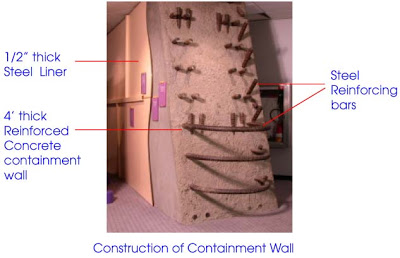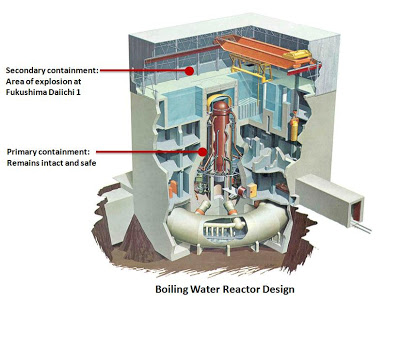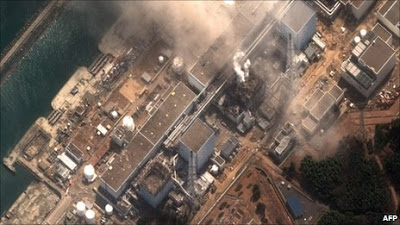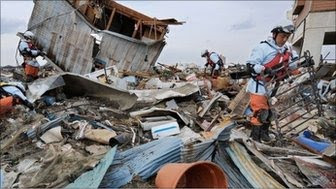Japan's Damaged Reactors: No Chernobyl
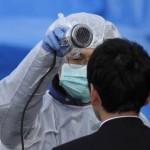 UPDATED: The quake-damaged reactors still haven't released enough radiation to harm the public, a testament to good design and emergency planning.
UPDATED: The quake-damaged reactors still haven't released enough radiation to harm the public, a testament to good design and emergency planning.
"The first quality for a commander-in-chief is a cool head to receive a correct impression of things. He should not allow himself to be confused by either good or bad news." - Napoleon
While it is premature to draw conclusions from the tragedy in Japan, we can certainly consider what is taking place a "worst case" disaster. Thus far though, even the most seriously damaged of its 54 reactors has not released radiation at levels that would harm the public. That is a testament to their design and construction, and the effectiveness of their employees and their emergency preparedness planning.
Following Friday's devastating earthquake, uranium fuel rods were exposed for at least two and a half hours. There was some burning of nuclear fuel, as evidenced by the presence of radioactive hydrogen and cesium, and partial meltdowns did occur. However, as I've pointed out before, the explosions witnessed were not the reactors themselves blowing up, nor were they the primary containment. The primary containment that houses and protects the reactor vessel and fuel remains intact and is safe. This structure is made of steel and steel-reinforced concrete and is extremely robust.
Life-size, cut-away replica of a nuclear power plant containment wall. The reactor is located inside of the containment building. The rebar within the concrete is about the size of a man's forearm. Photograph courtesy Entergy.
The primary and secondary containment are designed to prevent radiation from being released into the environment in the case of an accident. However, TEPCO (Tokyo Electric Power Company) intentionally vented steam from the secondary containment building in an effort to reduce pressure in that building. What we saw blow up was the secondary containment, the sheet metal building that sits on top of the cement containment. The reactor's containment performed according to design.
It appears that as the level of coolant in the reactor vessel lowered, a portion of the top of the uranium fuel rods was exposed. This may have caused zirconium cladding of the fuel rods to react with water to create hydrogen. This hydrogen was vented, then somehow ignited, causing the explosion.
As the explosion did not occur inside the reactor core, and the primary containment was not breached, there has not been a significant public health impact from the release of radiation from the containment structure.
Reactors 2 and 3 at Fukushima Daiichi were shut down in response to the earthquake. Units 4, 5 and 6 had been shut down prior to the earthquake for inspections and scheduled outages.
In response to the emergency conditions, TEPCO has been pumping seawater, laced with boron, into the reactor.
According to information provided by TEPCO:
Fukushima Daiichi Unit 1 was shut down at 2:48pm on March 11th. The reactor was shut down, reactor water level was stable, and offsite power was available.
At 8:19am, March 12th, there was an alarm indicating that one of the control rods was not properly inserted. However at 10:43am the alarm was spontaneously called off. Other control rods were confirmed fully inserted and the reactor was in a subcritical status.
o Status of main steam isolation valve: closed.
o Injection of water into the reactor by the Make-up Water Condensate System.
o There was not believed to be any leakage of reactor coolant in the containment vessel at this time.
o At 5:22am March 12th, the temperature of the suppression chamber exceeded 100 degrees. As the reactor pressure suppression function was lost, at this time it was determined that a "significant nuclear incident" had occurred.
o We decided to prepare implementing measures to reduce the pressure of the reactor containment vessel (partial discharge of air containing radioactive materials) in order to fully secure safety. This preparation work started at around 9:43am March 12th and finished at 6:30pm the same day.
o Restoration work in reactor cooling function that was conducted to achieve reactor cold shutdown was completed and cooling of the reactor commenced at 1:24 am, March 14th.
o It was confirmed afterwards that the average water temperature of suppression chamber was constantly below 100 degrees.
Fukushima Daiichi Unit 2 was shut down at 2:48pm on March 11th. The reactor was shut down and reactor water level was stable, offsite power was available, and control rods were fully inserted, rendering the reactor in a subcritical status.
o Status of the main steam isolation valve: closed.
o Water was injected into the reactor by the Make-up Water Condensate System.
o It is not believed that there was leakage of reactor coolant in the containment vessel.
o At 5:32am March 12th, the temperature of the suppression chamber exceeded 100 degrees. As the reactor pressure suppression function was lost, at 5:32am March 12th it was determined that a "significant nuclear incident" had occurred.
o We decided to prepare implementing measures to reduce the pressure of the reactor containment vessel - a partial discharge of air containing radioactive materials - in order to fully secure safety. This preparation work started at around 10:33am March 12th and was completed by 10:58pm March 12th.
o Restoration work in the reactor cooling function was in progress to achieve reactor cold shutdown.
o Restoration work in reactor cooling function conducted to achieve reactor cold shutdown was completed and cooling of the reactor commenced at 7:13 am, March 14th.
o It was confirmed afterwards that the average water temperature in the suppression chamber was constantly below 100 degrees.
A satellite photo of the Fukushima Daiichi plant showed the damage done to reactors 1 and 3, where there was an explosion on Monday.
Fukushima Daiichi Unit 3 was shut down at 2:48pm on March 11th.
o The reactor was shut down, reactor water level was stable, offsite power was available, control rods were fully inserted, and the reactor was in a subcritical status.
o Status of the main steam isolation valve: closed
o There was not believed to have been leakage of reactor coolant in the containment vessel, but measures to reduce the pressure of the reactor containment vessel via partial discharge of air containing radioactive materials were implemented in order to fully secure safety. The preparation work started at around 12:00pm March 12th and finished at 12:13pm March 12th.
o Reactor cold shutdown occurred at 12:15pm March 12th
Fukushima Daiichi Unit 4 shut down at 2:48pm on March 11th. The Reactor was shut down, reactor water level was stable and offsite power was available. At 0:43PM, there was a signal indicating that one of the control rods may have not properly inserted. However, another signal confirmed it completely inserted. The reason for this in under inspection.
o Status of main steam isolation valve: closed
o Injection of water into the reactor is done by Make-up Water Condensate System.
o There is not believed to be a leakage of reactor coolant in the containment vessel.
o In order to cool down the reactor, water was injected into the reactor by the Reactor Core Isolation Cooling System. However, at 6:07am March 12th, the temperature of the suppression chamber exceeded 100 degrees. As the reactor pressure suppression function was lost, at 6:07am March 12th it was determined that a "significant nuclear incident" had occurred.
o It was decided to prepare implementing measures to reduce the pressure of the reactor containment vessel - partial discharge of air containing radioactive materials - in order to fully secure safety. This work started at around 11:44am March 12th and finished at around 11:52am March 12th.
o Restoration work that was conducted to achieve reactor cold shutdown was completed and cooling of the reactor commenced at 3:42pm March 14th.
At approximately 11:01am, an explosive sound followed by white smoke occurred at the reactor building of the Fukushima Daiichi Unit 3. It was believed to be a hydrogen explosion.
As of 4:00 pm, the measured value of radiation dose at the monitoring post in Fukushima Daiichi Power Station remained at ordinary levels. No radiation impact to the external environment has been confirmed.
The possibility of radioactive material being discharged from exhaust stack or discharge canal is continuing to be monitored in detail. As of 4:00 pm, the measured value of radiation dose at the monitoring post in Fukushima Daiichi Power Station remains at the ordinary level. No radiation impact to the external environment has been confirmed.
Timelines info source: TEPCO
The fact of the matter is the people of the tsunami-hit regions have a lot more to worry about than conditions at the nuclear power plants. They need food, clean water, shelter from the elements, and medical assistance. Radiation can be mitigated by time, shielding & distance.
There is one thing though of which we can be certain: a) Given the basic design features of the Fukushima Daiichi plant, a Chernobyl-type disaster was never a possibility. The fact of the matter is that our modern society needs electrical power, and to get that electrical power, current must be generated by turbine generators.
It takes energy to turn those turbines, in the form of steam (or in the case of hydro-electric dams, water driven by gravity). To boil water to make steam takes a source; heat, from either nuclear fission, or coal, oil or natural gas. Wind and sunshine simply cannot generate the current, and we cannot depend upon them for energy without accepting some serious cutbacks in our lifestyle; like, say, doing without air conditioning, television, X-ray machines, and modern manufacturing processes.
Incidents like what took place over the weekend are the risks we accept, to maintain our modern quality of life. It was bad, and our hearts go out to those injured by the events at the Fukushima Daiichi plant, to the hundreds of thousands displaced by Friday's terrible events, and to the tens of thousands dead, injured and missing.
UPDATE: Since my last posting, I spoke with a senior reactor operator licensed on a facility in the United States that is very similar to the ones that are having issues in Japan.
A point we hear no mention of in the media is that General Electric designed these plants and actually manufactured the reactors for some of them.
When an engineering firm designs a plant and presents the specifications to the potential client (in this case the Japanese) it is the responsibility of the client to inform the design team of the natural phenomena - seismic events, atmospheric events - that may occur in their region. Then the designers do a final safety analysis report to determine whether this plant can meet those specific local events, and then the regulatory agencies confirm that.
However the Japanese made a significant mistake; they failed in their assessment about the tsunami. It was the tsunami that caused the failure of the plant's safety components: i.e., seawater mixing with the diesel fuel for the emergency back-up generators. The plant' reactors did in fact handle an earthquake that was 9 on the Richter Scale.
This is significant because even though the Japanese miscalculated what natural phenomena they needed to prepare for, the American-designed, the American-built plant withstood a "Beyond-Design Basis Event".
This plant is 40 years old, which means of course they miscalculated 40 years ago. The ironic thing is this plant was intended to be taken offline in 2011, and the Japanese had recently given it a ten-year life extension. Of course, it’s offline now.
The point is that the American nuclear industry has designed our plants according to careful analysis of local events; we're not going to have a tsunami here.
The media should be praising General Electric and their designers, but the fact of the matter is that we will never hear of this positive aspect about nuclear power in the mainstream media.
Posted on March 16, 2011 at 10:40am
UPDATE: As of 5:00 pm Tuesday: Tokyo Electric Power Company (TEPCO) said that an oil leak in a cooling water pump at Unit 4 was the cause of a fire that burned for approximately 140 minutes. The fire was not in the spent fuel pool, as reported by several media outlets. Unit 4 was in a 105-day-long maintenance outage at the time of the reactor damage and there is no fuel in the reactor.
Posted on March 16, 2011 at 11:30 am
UPDATE: According to the National Energy Institute:
Fukushima Daiichi:
The reactors at the Fukushima Daiichi plant are in stable condition and are being cooled with seawater, but workers at the plant continue efforts to add cooling water to fuel pools at reactors 3 and 4.
The status of the reactors at the site is as follows:
Reactor 1’s primary containment is believed to be intact and the reactor is in a stable condition. Seawater injection into the reactor is continuing.
Reactor 2 is in stable condition with seawater injection continuing. The reactor’s primary containment may not have been breached, Tokyo Electric Power Co. and World Association of Nuclear Operators officials said on Thursday.
Access problems at the site have delayed connection of a temporary cable to restore off-site electricity. The connection will provide power to the control rod drive pump, instrumentation, batteries and the control room. Power has not been available at the site since the earthquake on March 11.
Reactor 3 is in stable condition with seawater injection continuing. The primary containment is believed to be intact. Pressure in the containment has fluctuated due to venting of the reactor containment structure.
TEPCO officials say that although one side of the concrete wall of the fuel pool structure has collapsed, the steel liner of the pool remains intact, based on aerial photos of the reactor taken on March 17. The pool still has water providing some cooling for the fuel; however, helicopters dropped water on the reactor four times during the morning (Japan time) on March 17. Water also was sprayed at reactor 4 using high-pressure water cannons.
Reactors 5 and 6 were both shut down before the quake occurred. Primary and secondary containments are intact at both reactors. Temperature instruments in the spent fuel pools at reactors 5 and 6 are operational, and temperatures are being maintained at about 62 degrees Celsius. TEPCO is continuing efforts to restore power at reactor 5.
Fukushima Daini:
All four reactors at the Fukushima Daini plant have reached cold shutdown conditions with normal cooling being maintained using residual heat removal systems.
Posted on March 17, 2011 at 6:00pm
Originally published at STORMBRINGER.
Tweet


